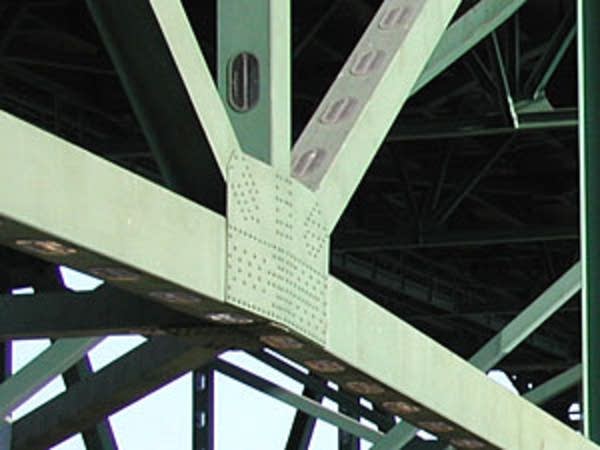Focus on gusset plates called 'overblown'
Go Deeper.
Create an account or log in to save stories.
Like this?
Thanks for liking this story! We have added it to a list of your favorite stories.

On Wednesday, the NTSB said it had observed what it called "a design issue" with gusset plates on the bridge. Then U.S. Transportation officials said stress on the plates may have been a factor in the collapse.
Those comments really turned the spotlight on gusset plates. That led to lots of news coverage implying they may well be a critical factor in the collapse.
But on Thursday, Bruce Magladry, director of the NTSB's Office of Highway Safety, said media attention to the bridge's gusset plates has been overblown.

Magladry said the plates are important, but they're just one of many components and issues the NTSB will be investigating.
Turn Up Your Support
MPR News helps you turn down the noise and build shared understanding. Turn up your support for this public resource and keep trusted journalism accessible to all.
"Gussets are in every steel truss bridge. They are a critical member of the bridge. It is what ties the assorted beams together. I think people may have run too far with that piece information," said Magladry. "It is another thing to look at, the same as we're looking for fractures in any piece of steel."
Magladry said the NTSB will be examining the plates to see what shape they're in, and if the plates used on the bridge were strong enough to begin with.
The NTSB is also looking into the weight placed on the bridge when it collapsed. At the the time of the collapse, the bridge was getting a new roadbed. So the bridge had heavy construction equipment and material on it.
"What you need to understand is how rare this event really is. Bridges don't fall."
On the other hand, the bridge had less than its usual load of traffic because half the lanes were closed for the repair work. Presumably that means there was less weight than usual on the bridge. But the NTSB says it's still trying to gauge the weight on the bridge when it failed.
MnDOT bridge engineer Dan Dorgan said the structure was designed to support a full load of cars, bumper to bumper, with every lane full.
"It's designed for the entire deck width as carrying traffic. When the bridge was originally opened we had two lanes in each direction. Nevertheless, the bridges are always designed as though the entire deck is carrying traffic," said Dorgan. "We do not know what will happen in the future, or what kind of vehicles may be broken down on the side."
The NTSB's Bruce Magladry says bridges are intended to carry far more weight than they'd ever be expected to bear.
"In your design model, you fill it full of tractor trailers. Bumper-to-bumper tractor trailers. And then there's a margin of safety," said Magladry.
MnDOT had employees monitoring the construction work on the bridge. MnDOT spokesman Kevin Gutknecht said they didn't see any trouble coming.

"We had three folks from MnDOT on the project that day. They were inspecting the construction work," said Gutknecht. "They're watching to make sure the contractor doing the work is meeting the contract specifications. For instance, one guy's job is to make sure the concrete meets the consistency and quality standards MnDOT specified in the contract."
The NTSB has indicated it could be 12 to 18 months before it reaches any conclusions about why the bridge came down. The board will review everything from the bridge's design and maintenance to the steel and concrete that went into it.
NTSB chairman Mark Rosenker said the work can't be rushed.
"We will take our time. Because when we get it, it will be right," said Rosenker. "And when we get it right and provide the probable cause, we'll also be making recommendations to prevent this kind of thing from happening again."
The agency's Bruce Magladry points out the board has few precedents to go on.
"What you need to understand is how rare this event really is. Bridges don't fall," said Magladry. "We knock down bridges sometimes. There are bridges that have been knocked down by barges and ships. Highway bridges are sometimes knocked down by trucks. But an accident like this one is very, very, very rare."
The NTSB has completed its investigation of the accident scene, and state and local officials have been cleared to remove debris.




